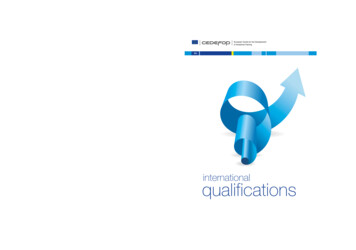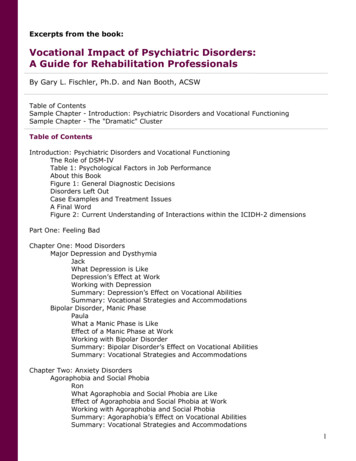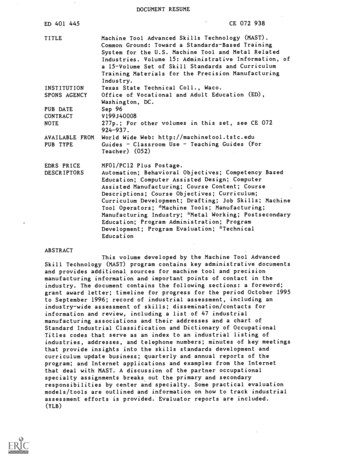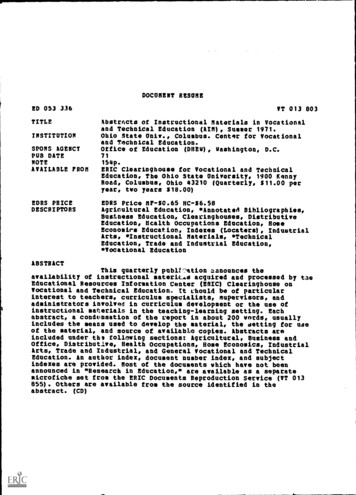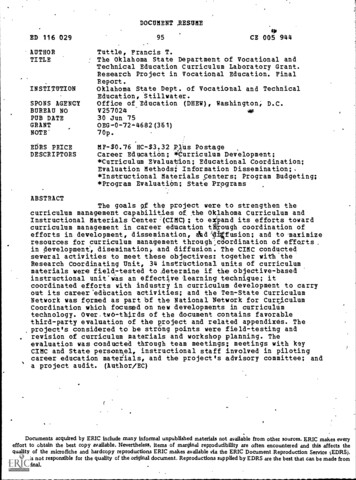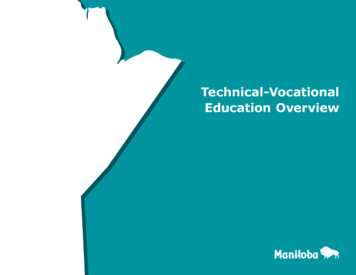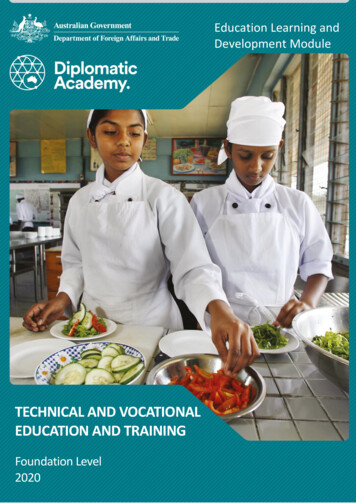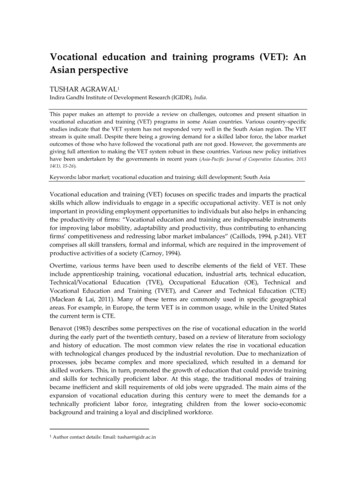
Transcription
Vocational education and training programs (VET): AnAsian perspectiveTUSHAR AGRAWAL1Indira Gandhi Institute of Development Research (IGIDR), India.This paper makes an attempt to provide a review on challenges, outcomes and present situation invocational education and training (VET) programs in some Asian countries. Various country-specificstudies indicate that the VET system has not responded very well in the South Asian region. The VETstream is quite small. Despite there being a growing demand for a skilled labor force, the labor marketoutcomes of those who have followed the vocational path are not good. However, the governments aregiving full attention to making the VET system robust in these countries. Various new policy initiativeshave been undertaken by the governments in recent years (Asia-Pacific Journal of Cooperative Education, 201314(1), 15-26).Keywords: labor market; vocational education and training; skill development; South AsiaVocational education and training (VET) focuses on specific trades and imparts the practicalskills which allow individuals to engage in a specific occupational activity. VET is not onlyimportant in providing employment opportunities to individuals but also helps in enhancingthe productivity of firms: “Vocational education and training are indispensable instrumentsfor improving labor mobility, adaptability and productivity, thus contributing to enhancingfirms’ competitiveness and redressing labor market imbalances” (Caillods, 1994, p.241). VETcomprises all skill transfers, formal and informal, which are required in the improvement ofproductive activities of a society (Carnoy, 1994).Overtime, various terms have been used to describe elements of the field of VET. Theseinclude apprenticeship training, vocational education, industrial arts, technical education,Technical/Vocational Education (TVE), Occupational Education (OE), Technical andVocational Education and Training (TVET), and Career and Technical Education (CTE)(Maclean & Lai, 2011). Many of these terms are commonly used in specific geographicalareas. For example, in Europe, the term VET is in common usage, while in the United Statesthe current term is CTE.Benavot (1983) describes some perspectives on the rise of vocational education in the worldduring the early part of the twentieth century, based on a review of literature from sociologyand history of education. The most common view relates the rise in vocational educationwith technological changes produced by the industrial revolution. Due to mechanization ofprocesses, jobs became complex and more specialized, which resulted in a demand forskilled workers. This, in turn, promoted the growth of education that could provide trainingand skills for technically proficient labor. At this stage, the traditional modes of trainingbecame inefficient and skill requirements of old jobs were upgraded. The main aims of theexpansion of vocational education during this century were to meet the demands for atechnically proficient labor force, integrating children from the lower socio-economicbackground and training a loyal and disciplined workforce.1Author contact details: Email: tushar@igidr.ac.in
AGRAWAL: Asian VET programAfter the mid-twentieth century, independent nations started expanding post-primaryeducation and many vocational training programs were introduced at the secondary level(Benavot, 1983). During the post-World War II period, many international agencies, such asthe International Labor Organization (ILO) and UNESCO, played major roles in thedevelopment of vocational education. It has been opined that after the Second IndustrialRevolution at least three ‘ideal models’ of the vocational system emerged. One is a marketled system in which a labor market characterized by substantial mobility provides much ofthe vocational training. Another is a school model where most of the VET takes place inschools. And third is a dual model with the presence of an apprenticeship system (Nilsson,2010). These models continue to distinguish today’s national systems.In recent years, creation of a skilled labor force has been a challenge in many countries,where there is a growing demand for a skilled labor force which has remained unfulfilled. Tomeet the requirement for a skilled labor force, more emphasis has been given to the VETprograms. This issue has been at the centre of the policy agenda of many nationalgovernments, particularly in the South Asian countries. Governments in these countries haveinitiated various steps towards building a sound VET system.This paper discusses the current scenario, challenges, outcomes and policy measures taken inVET programs in some of the South Asian countries: Afghanistan, Bangladesh, India andPakistan. However, from a policy perspective, the case of two other Asian countries, Koreaand Singapore, is also discussed. The paper relies on the existing literature and does notattempt to provide comparison among these countries.2VOCATIONALIZE OR NOT TO VOCATIONALIZEWhether to vocationalize or not, has remained a debate in the literature (Psacharopoulos,1987; Abrokwa, 1995; Oketch, 2007), and the relative benefits differ from one country toanother. General or academic education is more flexible because it allows a person to changetheir job easily whereas largely vocational education is suitable for a particular type of work.Vocationally trained workers are more efficient in handling old technologies. However, sincetechnology is unpredictable and changes over time, such workers require frequent training,and general education enables workers to adapt to new technologies (Krueger & Kumar,2002). VET is important in other aspects such as alleviating mass unemployment, providingspecific skills for self employment, preventing mass movement of school leavers from ruralto urban areas, and re-orientating student attitudes towards the rural society (Lillis & Hogan,1983; Tilak, 2002).Another related issue is the extent to which the education system should be vocationalized.This is important for at least two reasons: firstly, how the required skills will be provided, ifnot through vocational education, and secondly, given the substantial amount of subsidyallotted to VET programs in many countries, whether the returns on this spending areoptimal. These issues are difficult to resolve, and owing partly to data unavailability, havehardly been addressed in the literature. Both the supply side (for example, Where shouldvocational education be focused?), and the demand side (for example, Who wants to bevocationally trained?) factors are important to identify in these issues. Another macroelement that influences this decision is the availability of job opportunities in an economy.2This is due to unavailability of data on VET in many of these countries. Moreover, data on VET is not uniform so doesnot allow comparison across the countries.Asia-Pacific Journal of Cooperative Education, 2013, 14(1), 15-2616
AGRAWAL: Asian VET programVET IN ASIAN COUNTRIESIn the Asian countries, experiences of the outcomes of VET are mixed. The policiesundertaken by the governments have played a major role in these countries. Japan, Koreaand Singapore are the best examples of the VET system being well established. In these threecountries, the VET system has contributed significantly in the process of economicdevelopment (ADB, 2004; Cantor, 1985). As Ul-Haq and Haq (1998) argued in the HumanDevelopment Report in South Asia 1998:[v]ocational and technical education is a passport to better employmentopportunities. This is the experience of Japan the East Asian industrializingtigers where unemployment rates have remained consistently low, bothbecause their populations possessed employable technical skills andbecause of the high economic growth rates that these skilled populationsengineered. (p. 96)Indonesia, Malaysia, Philippines, Thailand and Sri Lanka have ‘fairly developed’ VETsystems, whereas Bangladesh, China, India, Myanmar, Nepal and Pakistan have ‘patchy’VET systems (Tilak, 2002). In most of the South Asian regions, the system has not beensuccessful:The system of vocational and technical education in South Asia is thuscharacterized by low enrolment, high drop-outs, poor-quality of teachers,inequitable access for women and rural populations, limited private sectorinvolvement, and very inadequate budgetary allocations. In other words,technical training in South Asia is neither supporting a high economicgrowth rate, nor expanding global markets, nor increasing employmentopportunities. The whole system requires fundamental review andrestructuring. (Ul-Haq & Haq, 1998, p. 100)The following section will discuss the cases of the Asian countries of Afghanistan,Bangladesh, India, Pakistan, Korea and Singapore.3AFGHANISTANAccording to the Afghanistan Human Development Report-2007, Afghanistan is ranked 174 outof 178 countries (Wardak, Saba & Kazem, 2007). The youth literacy rate (15-24) of the countryis 39 per cent and for females it is only 29 per cent. The rates of unemployment and underemployment are in the range of 25 to 30 per cent, and 70 per cent of the unemployedpopulation have no or very few skills (World Bank, 2008b). In 2001, there were 38 TVETschools with 550 instructors and 1,510 male students. In 2008, 51 vocational schools wereactive in 22 provinces. Enrolment in technical and vocational education had increased fromabout 9,000 in 2006 to 16,000 in 2008 with a 16 per cent share of female students.The TVET system in Afghanistan is particularly important to rebuild the country since theconflict in the past decades has destroyed the country’s training infrastructure. There is anabsence of a well-educated and trained labor force and for this reason the growing demandfor skilled labor is being met largely by neighboring countries. A weak institutional andpolicy environment, poor outcomes and weak market linkages, disparities in access to3This paper uses a country-specific term (which is in common usage in that country) for VET.Asia-Pacific Journal of Cooperative Education, 2013, 14(1), 15-2617
AGRAWAL: Asian VET programeducational facilities across gender, geography and population subgroups, and inadequatefinancing for training and infrastructure facilities are the key issues in the training system(World Bank, 2008b). Teachers are not adequately trained and many of them have littleexposure to changes in technology or other advances in their field. The shortage of teachers isanother concern: there were only 674 TVET teachers in 2008 (Islamic Republic ofAfghanistan, 2007).A recent report, Afghanistan TVET Providers Inventory, produced for review by the UnitedStates Agency for International Development (USAID) raises some other issues in the TVETsystem such as weak linkage with market needs, under-utilization of on-line andinternational resources, and low women’s participation (USAID, 2011). A large proportion offemales in TVET are in the informal sector, participating in training in more traditionalfemale occupations like sewing, handicrafts, carpet weaving and beautician services.Every NGO is teaching women to sew and giving them sewing machinesat the end of training . There are so many women sewing that there is noone left to sell to: women just sew for their own families now. (USAID,2011, p. 21)There is a need to identify new skill areas in which there is unmet demand in the country.Not as much emphasis has been placed on training in emerging occupations and skills.According to a donor representative, every public hospital has a room fullof non-functioning medical equipment that has been purchased over thepast 10 years with donor funding. The cost of importing repair people fromGermany, the U.S., India and Japan (where the equipment ismanufactured) is prohibitive. This presents an excellent opportunity fordemand-driven TVET. Unfortunately, there is currently no trainingprogram teaching Afghans how to calibrate, maintain or repair thisdelicate equipment. Similar examples exist for other types of modernequipment. (USAID, 2011, p. 21)Of late, the Ministry of Education of the Islamic Republic of Afghanistan has developed aNational Strategic Education Plan (NSEP) 2010-2014. The plan sets out the policies andobjectives of the education system of Afghanistan which will be attained during the next fiveyears. The plan is structured around five priority programs designed for permitting theMinistry of Education to achieve the main objectives of the education system, one of thembeing TVET. The goal of the TVET program is to provide relevant and quality technical andvocational education for both males and females in order to enable them to meet therequirements of the labor market (Islamic Republic of Afghanistan, 2007).The objective of the program is to increase access to technical and vocational education byexpanding TVET regional institutes from 16 to 32, increasing TVET provincial schools from32 to 102, and establishing 364 TVET district schools by 2014. The number of students intechnical and vocational education will also increase to 150,000 with 30 per cent being femalestudents. In addition, the Ministry will promote the establishment of private TVET centersand will support major industries to set up training units within the industries in closecollaboration with chambers of commerce where students in grade 9 can enroll and obtainvocational training. The Ministry will, through public awareness, also encourage theenrolment in TVET of girl students and students from rural areas (Islamic Republic ofAfghanistan, 2007).Asia-Pacific Journal of Cooperative Education, 2013, 14(1), 15-2618
AGRAWAL: Asian VET programBANGLADESHThe level of education in Bangladesh has remained low. The literacy rate was 56.5 per cent in2009; however, the country has made remarkable progress towards increasing both primaryand secondary school enrolment. This progress has been attained despite a high povertylevel in the country. A large section of the population continues to live on subsistencefarming in rural villages. A survey report by the Bangladesh Bureau of Statistics (BBS, n.d.)shows that the labor force in the country has increased from 49.5 million in 2006 to 53.7million in 2009.4 The unemployed population rose from 2.1 million to 2.7 million from 2006to 2009 (BBS, n.d.).The Directorate of Technical Education was established in 1960 for the development oftechnical and vocational education. Later, in 1969, the Bangladesh Technical Education Board(BTEB) came into existence for organizing, supervising, regulating, controlling anddeveloping technical and vocational education. There was a total (public and private) of3,116 technical and vocational education institutions with 20,703 teachers and 453,375students (23.62% female enrolment) in 2008.5There is a scarcity of skilled labor; people with technical or vocational qualifications are inshort supply. One of the main problems is lack of linkages between employers and the jobmarket. The training institutes are not able to produce skills required to fulfill the marketdemand (CPD, 2001). Also, the quality of graduates is not good. In Bangladesh, 80 per cent ofemployed population is associated with the informal sector. Though the unemployment rateof the country is low (5%), the main problem has been the high underemployment rate whichis more than 28 per cent (BBS, n.d.). Underemployment rates of females are higher than thoseof males both in rural and urban areas. Given these facts, too little attention is paid to thetraining programs needed in the informal sector.A World Bank report states that the capacity utilization in the VET system is low; half of thestudent capacity is not utilized (World Bank, 2007). Although reliable estimates are notavailable, a tracer study of labor market outcomes finds that only 9.7 and 5.2 per cent ofmales and females, respectively, were employed after completion of the course. 6 About 47per cent were unemployed and 45 per cent were pursuing higher education. Wages ofgraduates of the VET system are also low compared to those with graduating from generaleducation. Financing of VET is also a problem due to their high cost, with the unit cost beingthree times higher than that of general higher education. A key contributing element for thehigh cost is the low student-teacher ratio. The large fixed and recurrent costs of machinery,the constant need for consumables, and a scholarship scheme provided to the large majorityof students are some other reasons for the high cost of training.However, due to skills mismatch and increasing overseas employment, there is a need forinvestment in the vocational system. The report suggests that the government should focuson improving the efficiency of the system rather expanding it. The development of a clearpolicy statement for the VET sector should be an immediate priority for the government(World Bank, 2007).The labour force comprises economically active population consisting of persons (aged 15 and above) employed forpay or profit during the specified week, plus persons who sought work during that week, the underemployed.5Ministry of Education, Government of the People's Republic of Bangladesh.6Although this tracer study is useful in examining performance of vocational graduates, but it should not be seen as asubstitute for a rigorous impact evaluation.4Asia-Pacific Journal of Cooperative Education, 2013, 14(1), 15-2619
AGRAWAL: Asian VET programINDIAVET programs in India have gained much greater attention in the past few years. Theprograms are in the main policy agenda of the government. During the Eleventh Five YearPlan (2007-12), a major ‘Skill Development Mission’ with an outlay of Rs. 228 billion waslaunched (Government of India, 2008, p. 91). VET programs are aimed at creatingemployment opportunities and imparting suitable skills for self employment, particularly inthe rural and unorganized sectors.There are 17 ministries/departments which administer VET programs; the Ministry ofHuman Resource Development and the Ministry of Labor and Employment (MoLE) are themajor ones. The programs are offered at secondary and higher secondary levels. Someprograms are also offered at pre-secondary level. Vocational education is offered at schoollevel in grades 11 and 12 in the formal schooling cycle. Vocational training includesinstitution-based training programs which fall outside the formal schooling cycle, and ismainly provided through public Industrial Training Institutes (ITIs), private IndustrialTraining Centers (ITCs) and polytechnics (both public and private).The Directorate General of Employment and Training (under the MoLE) initiated theCraftsmen Training Scheme (CTS) in 1950 for providing skills in various vocational trades tomeet the requirement for skilled manpower in the country and initially 50 ITIs wereestablished. The oil boom in West-Asia during the 1980s increased the demand for skilledmanpower in those regions resulting in the establishment of many new private traininginstitutes, particularly in the southern part of the country. In 2011-12, there are about 9000ITIs/ ITCs having a capacity of more than 1.2 million students under the MoLE. There are1244 polytechnics with a capacity of more than 295,000 students under the Ministry of HRD(Government of India, 2008, p. 88).7 In addition, a number of institutes are involved inproviding training for the informal sector under various ministries. Some of these areCommunity Polytechnics, Jan Shikshan Sansthan and National Institute of Open Schooling.Agencies like Khadi and Village Industries Commission, Entrepreneurship DevelopmentCenters, Department of Women and Child Development, and National Renewal Fund alsorun some training programs.According to the employment and unemployment survey of 2004-05 conducted by theNational Sample Survey Organization (Government of India), in the age group age 15-29years, about 2 per cent of the population are reported to have received formal vocationaltraining and another 8 per cent are reported to have received non-formal vocational training(Government of India, 2006). At present, the capacity in the VET programs is 3.1 millionstudents per year. The government has set a target of up-skilling 500 million people by 2022.However, the VET programs have also not been very successful in India. An ILOefficiency/impact evaluation study of the ITIs and ITCs, in three states of the country(Andhra Pradesh, Maharashtra and Orissa) shows that the labor market outcomes of thetrained candidates are not good. The study finds that in the states of Andhra Pradesh,Maharashtra and Orissa, 41, 35 and 16.2 per cent of graduates, respectively, from ITIs wereable to get wage employment/self-employment/joined family business. The correspondingpercentages for those graduating from ITCs were 22.8, 35.6 and 21.3 per cent, respectively(International Labor Organization ILO, 2003, p. 31).The number given for polytechnics is only for those who offer diploma courses in engineering. In addition, there are415 institutions for diplomas in pharmacy, 63 for hotel management and 25 for architecture courses.7Asia-Pacific Journal of Cooperative Education, 2013, 14(1), 15-2620
AGRAWAL: Asian VET programA World Bank report on skill development in India (World Bank, 2008a) also mentions othervarious issues in the Indian VET system. The report points out that more than 60 per cent ofall graduates remained unemployed even three years after completion of a course. Publictraining institutes are not able to fulfill their role in producing skills for the informal sector.There are several challenges in the existing system: quality and financing of the system, anineffective funding model, strong mismatch between demand and supply side factors, andlack of match between labor market needs and vocational courses. The report suggests thatthe major reforms in different areas are required before expanding the VET system andmaking the system more responsive to the need of the labor market.A recent study shows quite a high rate of unemployment (11%) for VET holders in the agegroup 15-29 years at the secondary level (Agrawal, 2012). Although the unemployment rateof VET holders is higher than the overall unemployment rate in the same age group, the rateis lower than that for general secondary graduates. The study also finds that average dailywages are higher, both for regular and casual workers, for VET holders.In recent years, the government has taken many initiatives such as encouraging publicprivate partnership, upgrading of ITIs into centers of excellence with the World Bankassistance and skill development initiative scheme.PAKISTANThe vocational and technical education stream in Pakistan is quite small. There are about315,000 students enrolled across 1,522 technical and vocational education and training(TVET) institutes (National Vocational and Technical Education Commission [NAVTEC],2009). Enrolment in the vocational and technical training institutions was planned to beraised to one million by 2010; a four-fold increase over 2005. Vocational institutes offercourses that vary from three months to two years in length, after grade 8. Vocationaleducation is provided through polytechnic, vocational training centers, apprenticeshipschemes, and various training and vocational institutions.TEVT in Pakistan is structured on a bi-layered pattern, at Federal level there is a NationalVocational & Technical Training Commission (NAVTTC) while at the provincial level thereare Technical Education & Vocational Training Authorities (TEVTAs). The programs areadministered by a number of federal, provincial and private agencies; vocational institutesare managed by the Provincial Education Department while Technical Training Centers andApprenticeship Training Centers are administered by the Provincial Labor Departments.Skill development has been among the most neglected areas in Pakistan. The country has notbeen able to improve vocational and job skills (Kemal, 2005). There are five main challengesin vocational education in the country. The first is the shortage of teachers: 30-40 per cent ofteaching posts are lying vacant and teachers do not have enough industrial experience. Thenext is course curriculum: most text books are imported and in the English language, thecurriculum followed in the institutes is out-dated and the examination system is mainlytheory oriented. The teaching and learning materials are of not good quality, and drop-outrates from the institutes are very high. Finally, there is a lack of linkages between schools andindustry (Amjad, 2005; Shah, 2010).Recently, the National Vocational and Technical Education Commission (NAVTEC) ofPakistan developed a seminal policy document Skilling Pakistan: National Skills Strategy 20092013 (NSS) (NAVTEC, 2009). The NSS has three main objectives: the provision of relevantAsia-Pacific Journal of Cooperative Education, 2013, 14(1), 15-2621
AGRAWAL: Asian VET programskills for industrial and economic development; the improvement of access, equity andemployability; and the assurance of quality through an integrated approach. The governmentis planning to set up additional technical and vocational institutions and increasing theenrolment in institutes.KOREAVET has played an important role in Korea's economic development by producing a skilledlabor force. Vocational education and training are separated in the country. Vocationaleducation is provided under the formal education system (under the Ministry of Educationand Human Resources Development) at the secondary level by vocational high schools andat the post-secondary level mainly by junior colleges. Vocational training is carried out asnon-formal training and comes under the Ministry of Labor. Vocational high schools offerthree year programs and fall into the following major categories: agriculture, technologyindustry, commerce, fishery and marine transportation, and comprehensive vocational.Junior colleges mainly provide two year programs that lead to a diploma or associate degree(Government of Alberta, 2009, pp. 37-39). In 2007, there were 702 vocational high schoolswhich accounted for slightly less than one third of the total high school enrolment and 148junior colleges (Chae & Chung, 2009).In the past, Korea’s VET has contributed substantially to economic and social developmentsbut the country is facing profound changes with the arrival of the knowledge based economyand global competition (Chung, 2010). Mismatch between demand and supply, lowparticipation rates of adult workers in education, linkage between school and industry andrigidity and linkages of VET System are some major issues in the current VET system. Anearlier study by Tzannatos and Johnes (1997) had also noted some of these problems. Thestudy mentioned that the curriculum does not match well with the requirements of theeconomy and is not flexible across regions with differing needs. There has been a shortage ofskilled technical workers within the manufacturing sector. The quality of vocationaleducation is also not high.A study by Chae and Chung (2009) finds that the status of VET system in the country isdeteriorating. Higher education is gaining much importance and general education isbecoming more attractive for students and their parents. Only 20 per cent of the vocationalhigh school graduates enter the labor market directly, whereas 70 per cent continue withhigher education. Their findings indicate that the current vocational high schools are notassociated with better labor market outcomes in terms of employment rate and wage levels.Still, the role of public vocational training cannot be neglected in order to supplement anymarket failure in the supply of labor. The study finds that the VET institutes are important insupplying technical labor to small and medium enterprises.SINGAPOREIn the economic and educational successes of Singapore, its education and training systemhas played a vital role.8 Singapore (and Korea) gave considerable attention to upgradingworkers on the job. For example, they introduced training levies to induce enterprise interestin worker training (ADB, 2004, p. 21). Singapore’s system of Vocational Technical EducationSeng (2008) and Mun (2008) provide a comprehensive overview on role of vocational education in economicdevelopment of Singapore.8Asia-Pacific Journal of Cooperative Education, 2013, 14(1), 15-2622
AGRAWAL: Asian VET program(VTE) is a ‘world-class model’ today (Seng, 2008, p. 129). In 1964, the government establishedthe first secondary vocational schools, initially with an enrolment of 4910 students (Boon &Gopinathan, 2008, p. 18). These were students who did not pass the primary leavingexaminations to enter into academic secondary schools. During the 1970s, several ITCs andvocational institutes were opened.In order to attract the multi-national companies (MNCs) and developing a strongmanufacturing sector to solve the unemployment problem, it was important for thegovernment to ensure that the requisite skills were in place. The government followed thesystematic policies and recommendations to upgrade education at various levels. Forexample, “as a way of tackling the ‘drop-out problem’ and the difficulties encountered bythose students who were not ‘academically inclined’, it was decided that the less‘academically-able’ students would now have a vocational route within the educationsystem” (Ashton, Green, James, & Sung, 1999, p. 38). The government has undertakenvarious reforms from time to time. An interesting innovation was the introduction of ascheme in 1993 similar to voucher system to further subsidize education and training(Tzannatos & Johnes, 1997). According to this scheme, the Ministry of Education makes aregular payment into an EduSave account for each child aged between 6 to 16 years. Parentsmay use the resources provided by this account to buy whatever additional education
vocational education and training (VET) programs in some Asian countries. Various country-specific studies indicate that the VET system has not responded very well in the South Asian region. The VET stream is quite small. Despite there being a growing demand for a skilled labor force, the labor market
